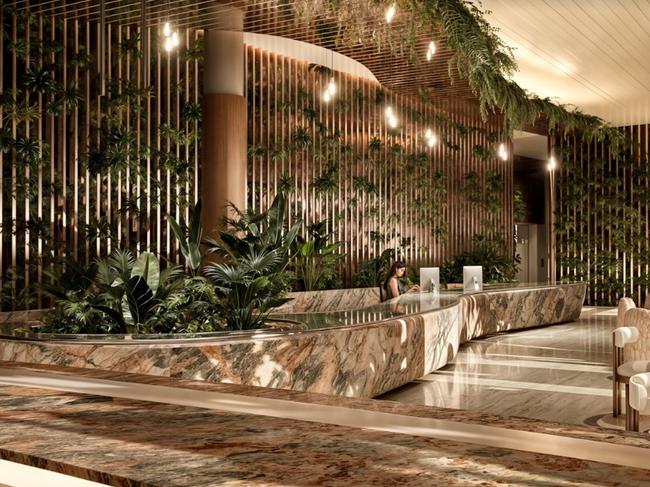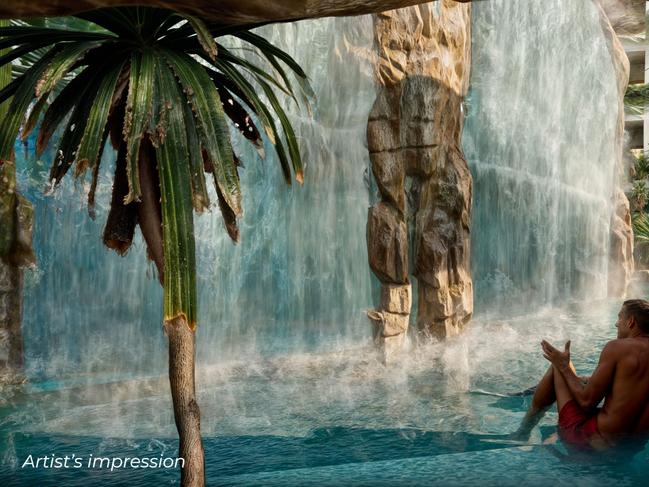Vote on Hervey Bay’s Sheraton hotel to go ahead this month
Environmental concerns have been raised regarding a 21-storey Sheraton hotel development proposed for a Queensland town ahead of a council vote later this month. See what the developer has to say.
Business
Don't miss out on the headlines from Business. Followed categories will be added to My News.
Concerns over the environmental impact of the proposed 21-storey Sheraton hotel development have been raised ahead of a council vote later this month.
Breannah Mitchell from Hervey Bay CoralWatch raised concerns about the effect of light pollution on Hervey Bay’s coral reef, which is 50m offshore.
Light pollution would impact the entire marine ecosystem, Ms Mitchell said, and in the case of the reef she said the light would compromise its ability to recover from natural stressors such as bleaching and flood.
She said darkness was crucial for corals to repair from stress.
Light pollution also would also affect the resting, feeding and predation in fish and marine animals.
Hervey Bay’s coral reefs were 6500 years old, Ms Mitchell said, and high coral cover had increased at Torquay from 2018 to 2023.
It was the only reef in Hervey Bay to expand over that five-year period.
It is the only coral reef in Australia so close to shore in an urban city centre.
Concerns about how the development, which is proposed by Sunny Beach Land, would impact on the nesting of endangered loggerhead turtles have also been raised.
Ms Mitchell said CoralWatch was not anti-development, but believed the current height restrictions in the town plan of 26m high should remain in place.
The 21-storey building proposed for Hervey Bay will reach 80m.
“The current tallest building along Mooloolaba Esplanade is 61m high,” she said.
Ms Mitchell said 91 per cent of the stormwater run-off from the proposed development would be directed through Tooan Tooan Creek, along with sediment and pollution.

She said the discharge would be dispersed directly onto fringing coral reefs and seagrasses.
Sunny Beach Land director Dan Cuda said the proposed Sheraton Resort Hervey Bay would be a “showcase of sustainable development that will set a new benchmark for the Fraser Coast region”.
“The planned resort, if approved, will feature a raft of best practice environmental measures to ensure the Torquay beachfront project has minimal impact on both the local environment and the surrounding community,” he said.
“The measures will include the latest in lighting design technology, stormwater management systems, landscaping design and sustainable building methods, while the resort will also play a leading role in educating visitors about the importance of protecting coral reefs and aquatic species.
“The project’s environmental credentials will complement the significant economic, employment and community benefits it will bring to the region, attracting new high spending tourists and helping to ease pressure on the Hervey Bay housing market.
“Plans for an Australian-first themed snorkelling and dive facility have also been announced as part of a natural oasis that will form the centrepiece of the resort.
“The deep dive facility will teach visitors how to snorkel and dive in a realistic reef environment while adopting environmentally conscious behaviours.


“There is no coral present for almost 400m from our development site, according to reliable public and private sources.
“The tide can go out at least 100m at Torquay Beach and coral cannot survive anything more than brief exposures out of the water.
“Our project will implement lighting design that complies with both Australian standards and the best practice lighting design described in the National Light Pollution Guidelines for Wildlife.
“This will ensure artificial lighting is not illuminating the beach or ocean.”
Mr Cuda said expert environmental study of sea turtle records did not identify any sea turtle species in the direct vicinity of the site.
“It concluded that the innovative lighting design we will implement will ensure there is minimal contribution to artificial skyglow from the project,” he said.
“As part of the Development Application, Sunny Beach Land commissioned a comprehensive expert environmental report on the potential impact of artificial light on sea turtles and shorebirds, covered under the Dark Sky Overlay Code in the Wide Bay Regional Plan.
“The study by Emily Krunes, an ecologist with more than 15 years’ experience, found no recent or historical sea turtle records in the direct vicinity of the development.”
Ms Krunes, director and principal of Trend Environmental said it was essential to recognise and address the potential environmental impacts associated with a beachfront development, particularly any potential impacts on sea turtles due to artificial light.

“However, it is important to highlight that there needs to be a balance between development and environmental protection,” she said.
“It is possible to have both, with a little innovative design and ensuring rigorous adherence to environmental standards.
“A sea turtle environmental impact study has been completed to assess the proposed development against the Dark Sky Overlay Code in the new Wide Bay Burnett Regional Plan.
“This study confirmed that impacts on sea turtles can be effectively mitigated with the implementation of best practice light design, in accordance with the National Light Pollution Guideline for Wildlife.
“This guideline was developed by the Commonwealth Government’s Department of Climate Change, Energy, the Environment and Water in consultation with numerous wildlife experts and has been endorsed by the International Convention on the Conservation of Migratory Species of Wild Animals.
“The Sheraton Resort Hervey Bay developers recognise the importance of protecting our wildlife and are committed to implementing an innovative light design that incorporates advanced LED technology that emits light at wavelengths less disruptive to sea turtles, alongside adaptive lighting controls and strategically directing lights away from the beachfront. These measures will ensure minimal contribution to artificial skyglow from the development.
“Protecting the Great Barrier Reef and its diverse array of species should begin with education.
“By informing locals and tourists about the critical importance and delicate nature of these ecosystems, we empower them to adopt more sustainable practices in their daily lives and inspire them to dedicate themselves to the long-term protection of our coral reefs.


“One of the most transformative experiences the resort will offer is to teach visitors how to snorkel and dive in a realistic reef environment.
“This allows them to witness firsthand the stunning beauty of the Great Barrier Reef, an experience that can profoundly shift their perspective and encourage more environmentally conscious behaviours, without the associated impacts of tourists on the reef itself. This will ultimately lead to better conservation outcomes for our reef.”
Earlier this year, Mr Cuda said the hotel component of the development was originally planned to have 187 rooms but would now be 223 rooms with Sheraton as the hotel operator and early planning under way for a snorkelling and dive pool.
Mr Cuda highlighted the study’s reference to the local area benefits of the project, including the $343m economic contribution, an extra $12m in annual visitor spending, 103,000 overnight visitors per year and employment for an estimated 50 apprentices.
“This report clearly demonstrates how much the local community will directly benefit from our plans despite a campaign of misinformation to the contrary,” he said.
“It also outlines many further flow-on effects for the Fraser Coast region, such as growth opportunities for local businesses, the potential to increase direct flights to Hervey Bay and the sustainability of the tourism sector due to more visitors spending more money.
“We knew that an operator of the calibre of Sheraton – part of the world’s largest luxury hotel group – would bring huge benefits to this region so we’re very excited to have this confirmed by economic experts.”

It comes as the Fraser Coast Regional Council announced that its July meeting would be held at a larger venue because of the community’s interest in the development application.
Council chief executive Ken Diehm said the meeting would now be held at a function room at Hervey Bay Golf Club.
“Council appreciates there is significant community interest in this development application,” he said.
“There is limited space in the current council chambers and foyer area at our Tavistock St office, so we have decided to move the July meeting to the Hervey Bay Golf Club function room to allow more people to attend.
“The meeting will be livestreamed on council’s YouTube channel, so there is an opportunity for those interested in the debate and decision on this development application to watch it online.
“Community presentations will start at 9am and the allocated time will be increased from half an hour to an hour.
“The council meeting will start at 10am and the development application will be the first report considered.
“During the council meeting immediately prior to the consideration of the development application, the developer will be invited to speak for a maximum of 15 minutes.
“This is consistent with council’s meeting procedures and standing orders, and has occurred previously, with The Spotlight Retail Group development a recent example.”
Mr Diehm said anyone attending council meetings was expected to behave appropriately and respectfully.
“Council meeting attendees should observe the direction of the chair, refrain from calling out and limit their conversations to ensure they do not disrupt the meeting,” he said.
Those attending will also be required to abide by the Hervey Bay Golf Club’s dress code.
Child rushed to hospital with life-threatening burns
‘Can’t film here’: Pauline Hanson returns to Mary Poppins’ statue after police threat




